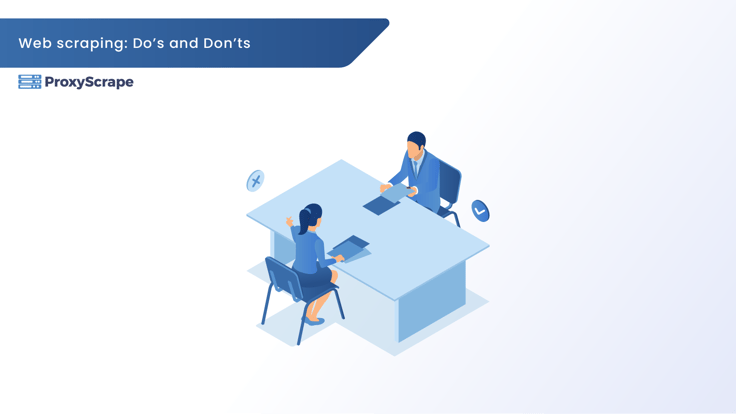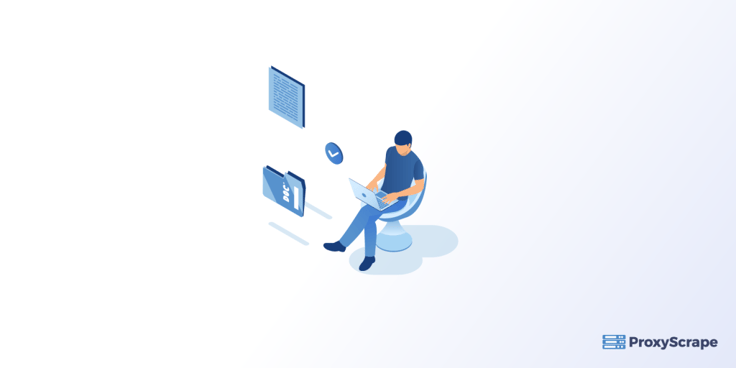Web Scraping: Do’s And Don’ts

Web scraping or web data extraction is an automated process of collecting data from a website. Businesses use web scraping to benefit themselves by making smarter decisions from the vast amount of publicly available data. They can extract data in an organized form so that it can be easier to analyze. Web scraping has many
Table of Contents
- What Is Web Scraping Used For?
- Web Scraping Do’s
- Web Scraping Don’ts
- Proxies for Web Scraping
- Proxy Integration
- Conclusion
Web scraping or web data extraction is an automated process of collecting data from a website. Businesses use web scraping to benefit themselves by making smarter decisions from the vast amount of publicly available data. They can extract data in an organized form so that it can be easier to analyze. Web scraping has many applications. For instance, it can be used for competitor price monitoring in the world of E-commerce. Businesses can fine-tune their price strategies by checking the prices of their competitors’ products and services to stay ahead of the game. Further, market research organizations can gauge customer sentiment by keeping track of feedback and online product reviews.
In general, the web scraping process involves the following steps.
- Identifying the target website
- Collecting the URLs of the pages whose data is to be extracted
- Making a request to these URLs for getting the page HTML
- Using locators to collect the data in the page HTML
- Storing the data in a structured format like a CSV or a JSON file
What Is Web Scraping Used For?
Given below are some of the use cases of web scraping.

Market Research – Market research is essential, and it needs to be driven by the most accurate data available. The organizations can do proper market research and gauge the customer sentiment if they have high volume, high quality, and high insightful web scraped data. The market analysts can perform the following tasks with web scraping.
- Research and Development
- Competitor Monitoring
- Market Pricing
- Market Trend Analysis
Real Estate – Real estate agents can make informed decisions within the market by incorporating web scraped data into everyday business. They perform the following tasks by using the scraped data from different websites.
- Estimation of rental yields
- Understanding market direction
- Appraisal of property value
- Monitoring vacancy rate
Content and News Monitoring – Web scraping is the ultimate solution to monitor, aggregate, and parse the critical stories from the industry if a company frequently appears in the news or depends on timely news analysis. The organizations can use web scraping for the following.
- Competitor Monitoring
- Public Sentiment Analysis
- Political Campaigns
- Investment Decision Making
Minimum Advertised Price (MAP) Monitoring – MAP monitoring makes sure that the online prices of brands are aligned with their pricing policy. It is impossible to monitor the prices manually as many sellers and distributors are there. Therefore, you can use the automated web scraping process to keep an eye on the products’ prices.
Web Scraping Do’s
You need to carefully extract the data from the web as you can harm the website function when scraping data. Therefore, you must be aware of all the do’s of web scraping.

Self Identification – It is a great practice to identify yourself when scraping data from the web. The target website can block your web crawler if you fail to follow the identification rule. You need to put your contact information into the crawler’s header. The system admins or webmasters can easily access the crawler’s information and notify you of any issue your crawler faces.
IP Rotation – Many websites have employed anti-scraping mechanisms to protect their websites from malicious attacks. If you do not know the basic mechanism of web scraping, you can get instantly blocked by the websites. The website can also block you if you employ the same IP for every request. Therefore, you need to use new IP for sending multiple requests to the target website. For this purpose, you can use proxies as they hide your identity from the website owners and assign you a pool of IP addresses. So, you can send multiple requests to the website using different IP addresses without getting blocked or banned.
Inspection of robots.txt – If you want to do web scraping, you need to inspect the robots.txt file closely. The robots.txt is a file that lets the search engines know which files they can and can not crawl using bots. Almost every website has this file, so you can acquire the rules of web scraping from this file. The robots.txt file contains significant information related to the number of requests that can be sent per second and the pages that can be visited.
CSS Hooks – You can use CSS selectors to find the HTML elements in web pages and collect data from them. When you select an element, the web scraper will try to guess the CSS selector for the selected elements. You can use the CSS selectors available in jQuery and the ones available in CSS versions 1-4(supported by the browser).
Web Scraping Don’ts
The don’ts of web scraping are given below.
Don’t Burden the Website – You should not harm the website from which you are scraping the data. Sometimes, the frequency and the volume of the requests can burden the web server. You can try accessing the data from the target website using a single IP; else, you can use proxies that can provide you with different IP addresses if you want to access the data from multiple pages.
Don’t Breach General Data Protection Regulation – You can not extract data of EU citizens in breach of GDPR as it is unlawful. With the introduction of GDPR, the scraped data of EU citizens is completely changed and altered. The valuable variants that can describe the data are name, number, age, email, contact, IP address, etc.
Don’t Use Fishy Techniques – You can use millions of Internet tools and tricks to bypass all the security protocols of a website with a few mouse clicks. But web admins can easily detect your tricks, and most of the time, they deceive you by avoiding your tricks. They can block you if they notice any activity that can harm their website. Therefore, you need to stick to the tools and services that uphold the target website’s reputation.
Don’t Hammer the Site – There is a huge difference between detecting live changes on a website and performing a Denial of Service (DOS) attack. As a web scraper, you need to know that you will be having a mild delay between requests. The website will detect your regular requests and block your IP if it has an IDS infrastructure.
Proxies for Web Scraping
You know that proxies act as intermediaries or third-party servers between the client sending the request and the server receiving the request. They are essential for web scraping as they extract data efficiently and reduce the chances of getting blocked. Proxies provide you with a number of IP addresses so you can send multiple requests to the target website using different IP addresses without getting banned. You can also access the geo-restricted content of websites using proxies.
In short, proxies are useful for web scraping for two reasons below.
- They hide the IP address of the source machine from the target website.
- They help to get past rate limits on the target website.
You can choose the following different types of proxies for web scraping.
Datacenter IPs – These are the server IP addresses hosted in data centers.
Residential IPs – They are more expensive than datacenter IPs and are the IP addresses of private households. You can use them to forward your request over a residential network.
Mobile IPs – These are the IPs of private mobile devices. The cost of mobile IP addresses is too high compared to other IPs.
Proxy Integration
You can integrate your proxies into existing web scraping software with the help of the following steps.
- Pass the web scraper’s requests through the proxy
- Rotate the IP addresses of the proxy server properly between requests
The first step is simple as you only need to import Python’s requests module and pass the proxy connection URL. Then, you have to send the get request to the target website, as shown in the steps below.
import requests
proxies = {'http': 'http://user:[email protected]:3128/'}
requests.get('http://example.org', proxies=proxies)The second step is a bit complicated and relies on how much parallel processing you do at a certain time and how much margin you want to keep with the rate limit of the target website.
Conclusion
With web scraping, you can collect data from a third-party website to use it according to your needs. It is super powerful for search engine result optimization, E-commerce price monitoring, lead generation, and news aggregation. Web scraping is not that simple as you need to take care of specific do’s and don’ts while collecting data from a website. You have to extract the data from a website in a way that does not harm the site nor alter its data. Proxies are pretty helpful for extracting data from websites as they hide your identity and prevent you from getting banned or blocked. You can use either a residential proxy or a datacenter proxy as per your needs.